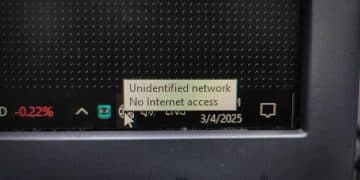FCC Fined Network $500,000: Broadcast Decency Violation Explained

The FCC imposed a $500,000 fine on a television network for violating broadcast decency standards, highlighting the ongoing debate over content regulation and freedom of speech in broadcasting.
The FCC fines network $500,000 for violating broadcast decency standards, reigniting discussions about the limits of permissible content on public airwaves and the role of regulatory bodies.
Understanding Broadcast Decency Standards
Broadcast decency standards are a set of rules established by the Federal Communications Commission (FCC) to regulate the content aired on television and radio, ensuring it aligns with societal norms and values. These standards aim to protect children from exposure to indecent material during certain hours.
The application of these standards can be complex, as it involves balancing freedom of speech with the need to safeguard community standards.
What Constitutes Indecent Material?
The FCC defines indecent material as language or depictions that, in context, depict or describe sexual or excretory organs or activities in a way that is patently offensive as measured by contemporary community standards for the broadcast medium.
Safe Harbor Hours
To mitigate the risk of exposing children to indecent material, the FCC has established “safe harbor” hours, generally between 10 p.m. and 6 a.m. local time, when broadcasters have more leeway in airing content that might be considered indecent. Programming outside these hours is subject to stricter scrutiny.

The FCC’s enforcement of broadcast decency standards often sparks debates about censorship and the role of government in regulating content. Critics argue that these regulations can chill artistic expression and limit the range of programming available to viewers, while proponents emphasize the importance of protecting children from harmful material.
Understanding these standards is crucial for both broadcasters and the public to navigate the complex landscape of content regulation.
The Specific Violation and FCC Action
The specific violation that led to the $500,000 fine involved the broadcast of content deemed indecent during hours when children were likely to be in the audience. The FCC reviewed the broadcast and determined that it violated established decency standards, prompting the agency to take enforcement action.
Details of the specific content are often kept confidential to avoid further dissemination of the material. However, the FCC’s decision serves as a warning to other broadcasters about the importance of adhering to decency standards.
The FCC’s review process involves a thorough examination of the broadcast content, considering the context in which it was aired and the potential impact on viewers, especially children.
- Review of the broadcast: The FCC reviews the content to determine if it violates decency standards.
- Contextual analysis: The FCC considers the context in which the content was aired.
- Potential impact assessment: The FCC assesses the potential impact on viewers, especially children.
The FCC’s decision to impose a $500,000 fine reflects the agency’s commitment to enforcing broadcast decency standards and protecting the public from indecent content. The action sends a clear message to broadcasters about the consequences of violating these regulations.
This action highlights the FCC’s dedication to upholding community standards and ensuring responsible broadcasting.
Impact on the Network and Broadcasting Industry
The $500,000 fine has a significant financial and reputational impact on the network involved. In addition to the monetary penalty, the network may face increased scrutiny from regulators and the public.
The fine also serves as a cautionary tale for other broadcasters, reminding them of the importance of compliance with decency standards.
The broadcasting industry is keenly aware of the FCC’s enforcement actions and the potential consequences of violating decency standards. Networks often implement internal controls to prevent the broadcast of indecent content and ensure compliance with regulations.
Increased Scrutiny
The network may face increased scrutiny from regulators and the public.
Reputational Damage
The fine also serves as a cautionary tale for other broadcasters, reminding them of the importance of compliance with decency standards.
- Review policies: Networks may review their internal policies and procedures for content review.
- Enhance training: Broadcasters may enhance training programs for employees to ensure compliance with decency standards.
- Implement technology: Networks may implement technology solutions to monitor and filter content.
The long-term effects of the fine could include changes in programming decisions and a greater emphasis on compliance within the broadcasting industry.
The industry response demonstrates a proactive approach to avoid similar penalties and safeguard their broadcast licenses.

The Ongoing Debate: Freedom of Speech vs. Regulation
The FCC’s enforcement of broadcast decency standards is often at the center of a broader debate about freedom of speech and the role of government regulation. Advocates for free speech argue that these regulations can stifle artistic expression and limit the range of programming available to viewers.
Proponents of regulation emphasize the importance of protecting children from harmful material and upholding community standards.
The debate over freedom of speech vs. regulation is a fundamental tension in broadcasting. The First Amendment to the U.S. Constitution protects freedom of speech, but this protection is not absolute. The government can impose reasonable restrictions on speech to protect legitimate societal interests.
First Amendment Considerations
The First Amendment to the U.S. Constitution protects freedom of speech, but this protection is not absolute.
Community Standards
Proponents of regulation emphasize the importance of protecting children from harmful material and upholding community standards.
- Balancing act: Finding the right balance between freedom of speech and regulation is a complex and ongoing challenge.
- Evolving standards: Community standards can change over time, requiring the FCC to adapt its enforcement policies.
- Legal challenges: FCC’s decency standards have been challenged in court on First Amendment grounds.
The resolution of this debate will continue to shape the landscape of broadcasting and the content available to viewers.
This ongoing discussion is critical in defining the future of media content and accessibility.
The FCC’s Role in Content Regulation
The FCC plays a central role in content regulation, overseeing the licensing and operation of broadcast stations, and enforcing rules related to indecency, obscenity, and violence. The agency’s authority is derived from the Communications Act of 1934, which gives it the power to regulate the airwaves in the public interest.
The FCC’s decisions have a far-reaching impact on the broadcasting industry and the content available to viewers.
The FCC’s role includes not only enforcing existing regulations but also adapting those regulations to reflect changes in technology and societal norms. The agency’s decisions are often subject to legal challenges and public scrutiny.
Enforcement Powers
The agency’s authority is derived from the Communications Act of 1934, which gives it the power to regulate the airwaves in the public interest.
Adapting to Change
The FCC’s role includes not only enforcing existing regulations but also adapting those regulations to reflect changes in technology and societal norms.
The FCC’s work is essential for maintaining a balance between freedom of expression and responsible broadcasting.
- Licensing: The FCC issues licenses to broadcast stations.
- Rulemaking: The FCC develops and implements rules and regulations for the broadcasting industry.
- Enforcement: The FCC enforces its rules and regulations, including those related to decency and obscenity.
The FCC’s ability to adapt to the evolving media landscape will be critical in shaping the future of broadcasting.
Future of Broadcast Decency Standards
The future of broadcast decency standards is uncertain, as technology and societal norms continue to evolve. The rise of streaming services and online content has created new challenges for regulators, as these platforms are not subject to the same decency standards as traditional broadcasters.
The FCC will need to adapt its policies to address these new challenges and ensure that decency standards remain relevant in the digital age.
The debate over broadcast decency standards is likely to continue for many years to come, as society grapples with the balance between freedom of speech and the need to protect community standards.
Challenges of the Digital Age
The rise of streaming services and online content has created new challenges for regulators, as these platforms are not subject to the same decency standards as traditional broadcasters.
Adapting Policies
The FCC will need to adapt its policies to address these new challenges and ensure that decency standards remain relevant in the digital age.
- Modernization: The FCC may need to modernize its decency standards to reflect changes in technology and societal norms.
- Enforcement: The FCC may need to develop new strategies for enforcing decency standards in the digital age.
- International cooperation: The FCC may need to cooperate with international regulators to address content regulation on a global scale.
The future of broadcast decency standards will depend on the FCC’s ability to navigate these challenges and adapt its policies to the changing media landscape.
This future requires a flexible approach that respects both creative freedom and public sensibilities.
| Key Point | Brief Description |
|---|---|
| ⚖️ FCC Fine | A network was fined $500,000 for violating broadcast decency standards. |
| 📺 Broadcast Standards | Regulations ensure content aligns with societal norms, especially for children. |
| 🎤 Free Speech | Decency standards spark debate on free speech vs. content regulation. |
| 🌐 Digital Challenges | Streaming services create new challenges for enforcing decency standards. |
Frequently Asked Questions
▼
Broadcast decency standards are rules set by the FCC to regulate content on TV and radio, ensuring it’s not patently offensive as measured by community standards.
▼
The FCC licenses broadcast stations, creates regulations, and enforces rules related to indecency, obscenity, and violence on public airwaves.
▼
The FCC fined the network $500,000 for broadcasting indecent content during hours when children were likely in the audience, violating decency standards.
▼
Decency standards spark a debate over freedom of speech, as they balance artistic expression with protecting community standards, especially for children.
▼
Streaming services create new challenges because they aren’t subject to the same decency rules as traditional broadcasters, demanding modern policy adaptations.
Conclusion
The FCC’s $500,000 fine underscores the ongoing importance of broadcast decency standards and the challenges regulators face in balancing freedom of speech with the need to protect community standards. As technology continues to evolve, the debate over content regulation will likely intensify, requiring ongoing dialogue and adaptation to ensure that broadcasting remains both responsible and innovative.





